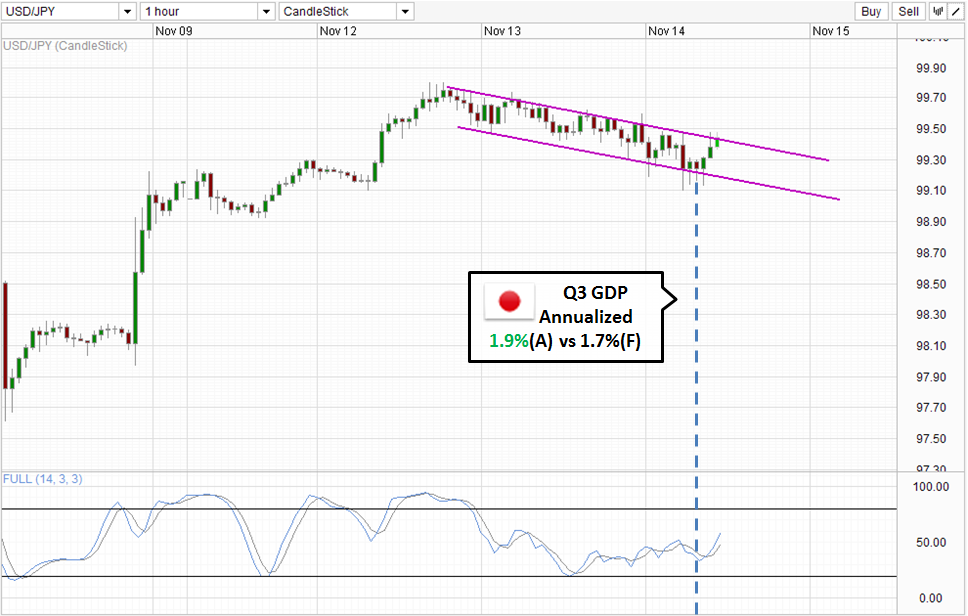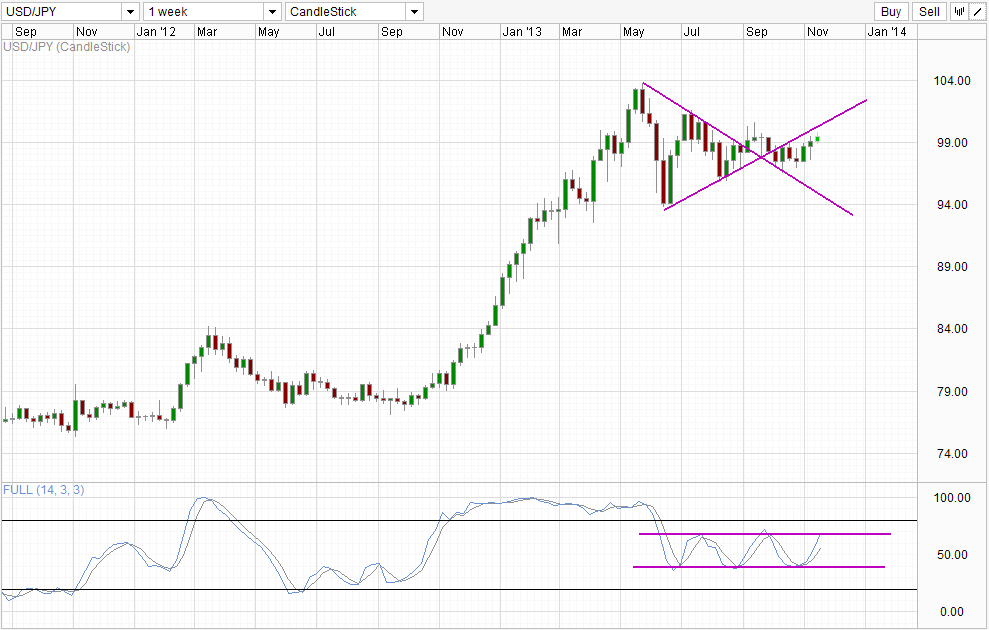Is Abenomics working or not? This largely depends on who you ask.
The incumbent Japanese Prime Minister’s supporter will point at the Q3 GDP numbers which were released earlier, where headline GDP figure grew 1.9% at an annualized rate, higher than the 1.7% expected.
However, opponents to Abenomics will point at the numbers beneath – Consumer spending grew at a paltry 0.1% Q/Q versus an expected 0.2% and previous quarter’s 0.6%, which was revised lower as well. Rate of growth in Business Spending is worse, coming in at 0.2% Q/Q versus analysts estimates of 1.0%. Similar to the consumer counterpart, previous quarter’s number have also been revised lower to 1.1%, highlighting that last quarter’s growth is indeed exaggerated.
Not only that, the rate of headline GDP growth is also lower than the previous quarter, and perhaps more importantly this is the 2nd consecutive quarter where GDP growth rate has shrank. This is not a good sign, and suggest that the bullish impact of BOJ stimulus announcement/Abenomics strategies are losing their potency. Then again, the growth rate continues to be much stronger than the past 20 years historical average, which suggest that Japanese economy remains on the right track, even though the train is moving slower than before.
Abenomics is certainly not a total failure, but definitely not a rousing success either. It is clear that what BOJ has done in the past is working, but in order to keep the growth going, it seems inevitable that another round of easing may be needed. ECB’s Draghi has done it recently with a surprise rate cut, while Yellen is sounding dovish and distancing herself away from any QE tapering scenario. The floor is all yours now Kuroda.
Hourly Chart
Market seems to agree, with USD/JPY trading higher post announcement as speculators believe that a stronger stimulus package may be announce by BOJ in December. However, technical influences remain strong, and we will need to see prices breaking Channel Top and preferably above the recent swing high of 99.8 in order for longer-termed bullish rally to emerge.
To complicate matters, there are another bunch of speculators who are betting on a QE Taper/No Taper scenario. Yellen’s testimony a couple of hours before the GDP release actually weakened USD following her dovish stance. As such, even if all speculators agree that global Central Banks will remain extremely dovish in late 2013/ early 2014, USD/JPY may still end up flat as BOJ will need to fight against the strong USD slide that is likely to follow.
Weekly Chart
Nonetheless, price action in 2013 gives us hope that BOJ will ultimately out-trump the Fed. It should be noted that we had both the Fed and BOJ easing this year, and USD/JPY has been pushing higher consistently. Interestingly, when QE Taper seemed like a surety back in September, the resulting surge in USD did not really pull USD/JPY higher, but instead market was trading sideways due to the Japan Sales Tax issue and BOJ’s silence on further stimulus packages. Hence, it is clear that BOJ action will have a stronger impact on USD, while the Fed’s Taper/No Taper narrative will simply be a backdrop (read: volatility and noise).
More Links:
GBP/USD – Pound Soars as UK Employment Data Shines
USD/CAD – Canadian Dollar Remains Under Pressure
EUR/USD -Steady as Eurozone Manufacturing Numbers Dip
This article is for general information purposes only. It is not investment advice or a solution to buy or sell securities. Opinions are the authors; not necessarily that of OANDA Corporation or any of its affiliates, subsidiaries, officers or directors. Leveraged trading is high risk and not suitable for all. You could lose all of your deposited funds.





